Seasonal Cycle of the Total Ozone Content over Southern High Latitudes in the CCM SOCOLv3
Abstract
1. Introduction
2. Materials and Methods
2.1. Data Used for Comparison
2.2. Cloud-J v.8.0
2.3. CCM SOCOLv3
2.4. Description of the Model Experiments
2.4.1. Reference Experiment (RR)
2.4.2. Sensitivity Experiments (SR1, SR2, SR3)
3. Results
3.1. Sensitivity to Heterogeneous Chemistry (SR1)
3.2. Sensitivity to the Subgrid-Scale Mixing (SR2)
3.3. Improved Photodissociation Rate Calculations Module (SR3)
4. Discussion
5. Conclusions
Author Contributions
Funding
Data Availability Statement
Acknowledgments
Conflicts of Interest
References
- Bernhard, G.H.; Neale, R.E.; Barnes, P.W.; Neale, P.J.; Zepp, R.G.; Wilson, S.R.; Andrady, A.L.; Bais, A.F.; McKenzie, R.L.; Aucamp, P.J.; et al. Environmental effects of stratospheric ozone depletion, UV radiation and interactions with climate change: UNEP Environmental Effects Assessment Panel, update 2019. Photochem. Photobiol. Sci. 2020, 19, 542–584. [Google Scholar] [CrossRef] [PubMed]
- Farman, J.C.; Gardiner, B.G.; Shanklin, J.D. Large losses of total ozone in Antarctica reveal seasonal ClOx/NOx interaction. Nature 1985, 315, 207–210. [Google Scholar] [CrossRef]
- Egorova, T.; Rozanov, E.; Gröbner, J.; Hauser, M.; Schmutz, W. Montreal Protocol Benefits simulated with CCM SOCOL. Atmos. Chem. Phys. 2013, 13, 3811–3823. [Google Scholar] [CrossRef]
- Eyring, V.; Shepherd, T.G.; Waugh, D.W. (Eds.) SPARC CCMVal Report on the Evaluation of Chemistry-Climate Models, 2010, SPARC Report No. 5, World Climate Research Programme, Report No. 30, WMO/TD-No. 1526. Available online: https://www.sparc-climate.org/publications/sparc-reports/sparc-report-no-5/ (accessed on 29 September 2025).
- Eyring, V.; Chipperfield, M.V.; Giorgetta, M.A.; Kinnison, D.E.; Manzini, E.; Matthes, K.; Newman, P.A.; Pawson, S.; Shepherd, T.G.; Waugh, D.W. Overview of the New CCMVal Reference and Sensitivity Simulations in Support of Upcoming Ozone and Climate Assessments and the Planned SPARC CCMVal. SPARC Newsl. 2008, 30, 20–26. Available online: https://www.atmosp.physics.utoronto.ca/SPARC/Newsletter30Web/53294-1%20SPRAC%20Newsletter-LR.pdf (accessed on 29 September 2025).
- Dhomse, S.S.; Kinnison, D.; Chipperfield, M.P.; Salawitch, R.J.; Cionni, I.; Hegglin, M.I.; Abraham, N.L.; Akiyoshi, H.; Archibald, A.T.; Bednarz, E.M.; et al. Estimates of ozone return dates from Chemistry-Climate Model Initiative simulations. Atmos. Meas. Tech. 2018, 18, 8409–8438. [Google Scholar] [CrossRef]
- Siddaway, J.M.; Petelina, S.V.; Karoly, D.J.; Klekociuk, A.R.; Dargaville, R.J. Evolution of Antarctic ozone in September–December predicted by CCMVal-2 model simulations for the 21st century. Atmos. Chem. Phys. 2013, 13, 4413–4427. [Google Scholar] [CrossRef]
- Karpechko, A.Y.; Maraun, D.; Eyring, V. Improving Antarctic Total Ozone Projections by a Process-Oriented Multiple Diagnostic Ensemble Regression. J. Atmos. Sci. 2013, 70, 3959–3976. [Google Scholar] [CrossRef]
- Corlett, G.K.; Monks, P.S. A Comparison of Total Ozone Values Derived from the Global Ozone Monitoring Experiment (GOME), the Tiros Operational Vertical Sounder (TOVS), and the Total Ozone Mapping Spectrometer (TOMS). J. Atmos. Sci. 2001, 58, 1103–1116. [Google Scholar] [CrossRef]
- Golovin, Y.M.; Zavelevich, F.S.; Nikulin, A.G.; Kozlov, D.A.; Monakhov, D.O.; Kozlov, I.A.; Arkhipov, S.A.; Tselikov, V.A.; Romanovskii, A.S. Spaceborne infrared Fourier-transform spectrometers for temperature and humidity sounding of the Earth’s atmosphere. Izv. Atmos. Ocean. Phys. 2014, 50, 1004–1015. [Google Scholar] [CrossRef]
- Wild, O.; Zhu, X.; Prather, M.J. Fast-J: Accurate Simulation of In- and Below-Cloud Photolysis in Tropospheric Chemical Models. J. Atmos. Chem. 2000, 37, 245–282. [Google Scholar] [CrossRef]
- Timofeyev, Y.; Uspensky, A.; Zavelevich, F.; Polyakov, A.; Virolainen, Y.; Rublev, A.; Kukharsky, A.; Kiseleva, J.; Kozlov, D.; Kozlov, I.; et al. Hyperspectral infrared atmospheric sounder IKFS-2 on “Meteor-M” No. 2—Four years in orbit. J. Quant. Spectrosc. Radiat. Transf. 2019, 238, 106579. [Google Scholar] [CrossRef]
- Polyakov, A.; Virolainen, Y.; Nerobelov, G.; Kozlov, D.; Timofeyev, Y. Six Years of IKFS-2 Global Ozone Total Column Measurements. Remote Sens. 2023, 15, 2481. [Google Scholar] [CrossRef]
- Waters, J.W.; Froidevaux, L.; Harwood, R.S.; Jarnot, R.F.; Pickett, H.M.; Read, W.G.; Siegel, P.H.; Cofield, R.E.; Filipiak, M.J.; Flower, D.; et al. The Earth Observing System Microwave limb sounder (EOS MLS) on the Aura satellite. IEEE Trans. Geosci. Remote Sens. 2006, 44, 1075–1092. [Google Scholar] [CrossRef]
- Fischer, H.; Birk, M.; Blom, C.; Carli, B.; Carlotti, M.; von Clarmann, T.; Delbouille, L.; Dudhia, A.; Ehhalt, D.; Endemann, M.; et al. MIPAS: An instrument for atmospheric and climate research. Atmos. Chem. Phys. 2008, 8, 2151–2188. [Google Scholar] [CrossRef]
- Burkholder, J.B.; Sander, S.P.; Abbatt, J.; Barker, J.R.; Huie, R.E.; Kolb, C.E.; Kurylo, M.J.; Orkin, V.L.; Wilmouth, D.M.; Wine, P.H. Chemical Kinetics and Photochemical Data for Use in Atmospheric Studies, Evaluation No. 18, JPL Publication 15-10, Jet Propulsion Laboratory, Pasadena. 2015. Available online: https://jpldataeval.jpl.nasa.gov/pdf/JPL_15_AllInOne.pdf (accessed on 29 September 2025).
- Atkinson, R.; Baulch, D.L.; Cox, R.A.; Crowley, J.N.; Hampson, R.F.; Hynes, R.G.; Jenkin, M.E.; Rossi, M.J.; Troe, J.; IUPAC Subcommittee. Evaluated kinetic and photochemical data for atmospheric chemistry: Volume II—Gas phase reactions of organic species. Atmos. Chem. Phys. 2006, 6, 3625–4055. [Google Scholar] [CrossRef]
- Bian, H.; Prather, M.J. Fast-J2: Accurate Simulation of Stratospheric Photolysis in Global Chemical Models. J. Atmospheric Chem. 2002, 41, 281–296. [Google Scholar] [CrossRef]
- Mayer, B.; Kylling, A. Technical note: The libRadtran software package for radiative transfer calculations-description and examples of use. Atmos. Chem. Phys. 2005, 5, 1855–1877. [Google Scholar] [CrossRef]
- Imanova, A.; Rozanov, E.; Smyshlyaev, S.; Zubov, V.; Egorova, T. Investigation of the Influence of Atmospheric Scattering on Photolysis Rates Using the Cloud-J Module. Atmosphere 2025, 16, 58. [Google Scholar] [CrossRef]
- Rozanov, E.V.; Zubov, V.A.; Schlesinger, M.E.; Yang, F.; Andronova, N.G. The UIUC 3-D Stratospheric Chemical Transport Model: Description and Evaluation of the Simulated Source Gases and Ozone. J. Geophys. Res. 1999, 104, 11755–11781. [Google Scholar] [CrossRef]
- Prather, M.J.; Hsu, J.C. A round Earth for climate models. Proc. Natl. Acad. Sci. USA 2019, 116, 19330–19335. [Google Scholar] [CrossRef]
- Stenke, A.; Schraner, M.; Rozanov, E.; Egorova, T.; Luo, B.; Peter, T. The SOCOL version 3.0 chemistry–climate model: Description, evaluation, and implications from an advanced transport algorithm. Geosci. Model Dev. 2013, 6, 1407–1427. [Google Scholar] [CrossRef]
- Hegglin, M.I.; Lamarque, J.F.; Eyring, V. The IGAC/SPARC Chemistry-Climate Model Initiative Phase-1 (CCMI-1) Model Data Output. NCAS British Atmospheric Data Centre. 2015. Available online: https://catalogue.ceda.ac.uk/uuid/9cc6b94df0f4469d8066d69b5df879d5 (accessed on 29 September 2025).
- WMO (World Meteorological Organization). Scientific Assessment of Ozone Depletion: 2018, Global Ozone Research and Monitoring Project, Report No. 58, Geneva. 2018. Available online: https://ozone.unep.org/sites/default/files/2019-05/SAP-2018-Assessment-report.pdf (accessed on 29 September 2025).
- Meinshausen, M.; Vogel, E.; Nauels, A.; Lorbacher, K.; Meinshausen, N.; Etheridge, D.M.; Fraser, P.J.; Montzka, S.A.; Rayner, P.J.; Trudinger, C.M.; et al. Historical greenhouse gas concentrations for climate modelling (CMIP6). Geosci. Model Dev. 2017, 10, 2057–2116. [Google Scholar] [CrossRef]
- Meinshausen, M.; Nicholls, Z.R.J.; Lewis, J.; Gidden, M.J.; Vogel, E.; Freund, M.; Beyerle, U.; Gessner, C.; Nauels, A.; Bauer, N.; et al. The shared socio-economic pathway (SSP) greenhouse gas concentrations and their extensions to 2500. Geosci. Model Dev. 2020, 13, 3571–3605. [Google Scholar] [CrossRef]
- Rayner, N.A.; Parker, D.E.; Horton, E.B.; Folland, C.K.; Alexander, L.V.; Rowell, D.P.; Kent, E.C.; Kaplan, A. Global analyses of sea surface temperature, sea ice, and night marine air temperature since the late nineteenth century. J. Geophys. Res. 2003, 108, 4407. [Google Scholar] [CrossRef]
- Giorgetta, M.A. Der Einfluss der quasi-zweijahrigen Oszillation: Modellrechnungen mit ECHAM4; Examensarbeit Nr. 40, MPI-Report 218; Max-Planck-Institut fur Meteorologie: Hamburg, Germany, 1996. [Google Scholar]
- Giorgetta, M.A.; Manzini, E.; Roeckner, E.; Esch, M.; Bengtsson, L. Climatology and forcing of the quasi-biennial oscillation in the MAECHAM5 Model. J. Clim. 2006, 19, 3882–3901. [Google Scholar] [CrossRef]
- Matthes, K.; Funke, B.; Andersson, M.E.; Barnard, L.; Beer, J.; Charbonneau, P.; Clilverd, M.A.; de Wit, T.D.; Haberreiter, M.; Hendry, A.; et al. Solar forcing for CMIP6 (v3.2). Geosci. Model Dev. 2017, 10, 2247–2302. [Google Scholar] [CrossRef]
- Kovilakam, M.; Thomason, L.W.; Ernest, N.; Rieger, L.; Bourassa, A.; Millán, L. The Global Space-based Stratospheric Aerosol Climatology (version 2.0): 1979–2018. Earth Syst. Sci. Data 2020, 12, 2607–2634. [Google Scholar] [CrossRef]
- Hoesly, R.M.; Smith, S.J.; Feng, L.; Klimont, Z.; Janssens-Maenhout, G.; Pitkanen, T.; Seibert, J.J.; Vu, L.; Andres, R.J.; Bolt, R.M.; et al. Historical (1750–2014) anthropogenic emissions of reactive gases and aerosols from the Community Emissions Data System (CEDS). Geosci. Model Dev. 2018, 11, 369–408. [Google Scholar] [CrossRef]
- Brasseur, G.P.; Solomon, S. Aeronomy of the Middle Atmosphere: Chemistry and Physics of the Stratosphere and Mesosphere; Springer: Dordrecht, The Netherlands, 2005. [Google Scholar] [CrossRef]
- Li, S.; Cordero, E.C.; Karoly, D.J. Transport out of the Antarctic polar vortex from a three-dimensional transport model. J. Geophys. Res. Atmos. 2002, 107. [Google Scholar] [CrossRef]
- Solomon, S. Stratospheric ozone depletion: A review of concepts and history. Rev. Geophys. 1999, 37, 275–316. [Google Scholar] [CrossRef]
- Wauben, W.M.F.; Bintanja, R.; van Velthoven, P.F.J.; Kelder, H. On the magnitude of transport out of the Antarctic polar vortex. J. Geophys. Res. 1997, 102, 1229–1238. [Google Scholar] [CrossRef]
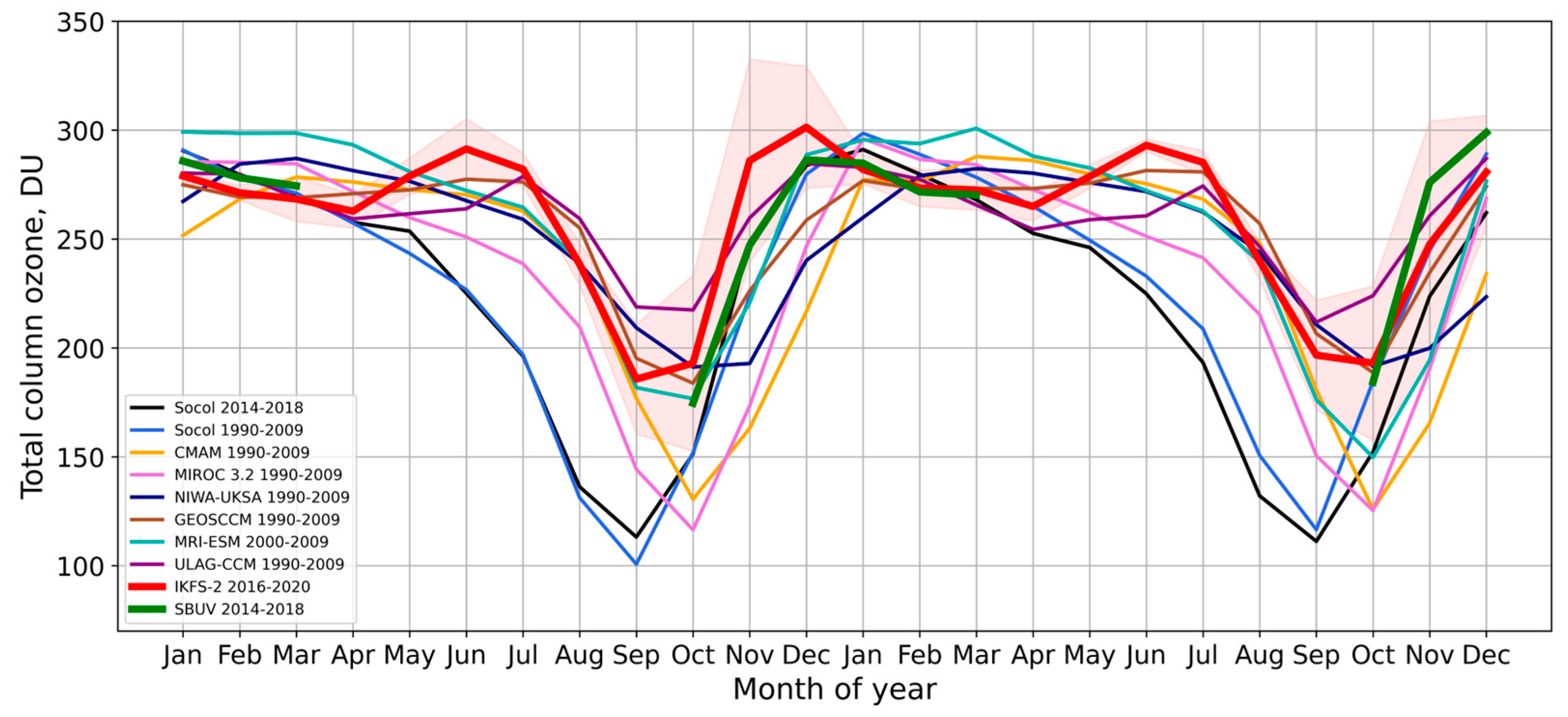
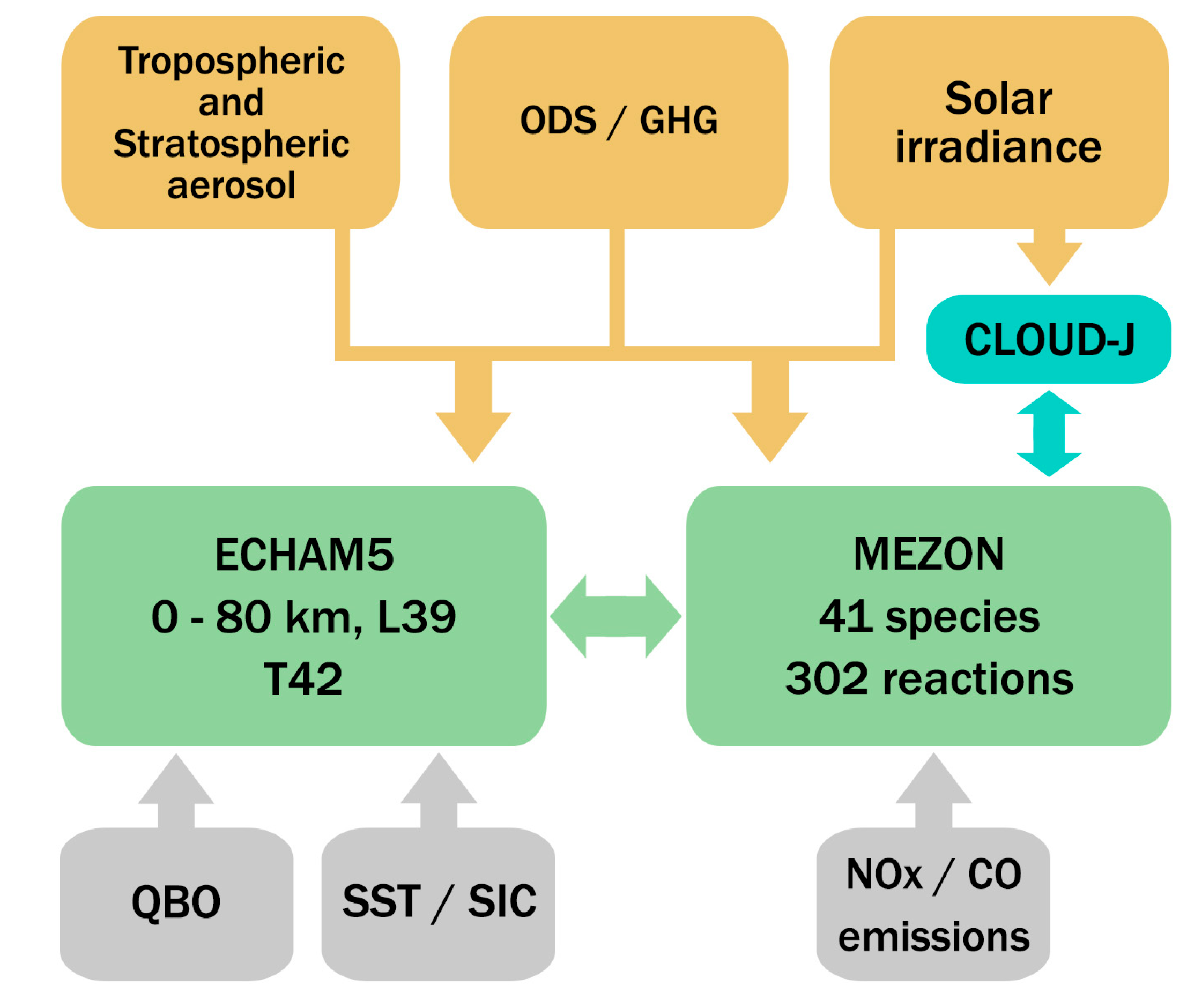
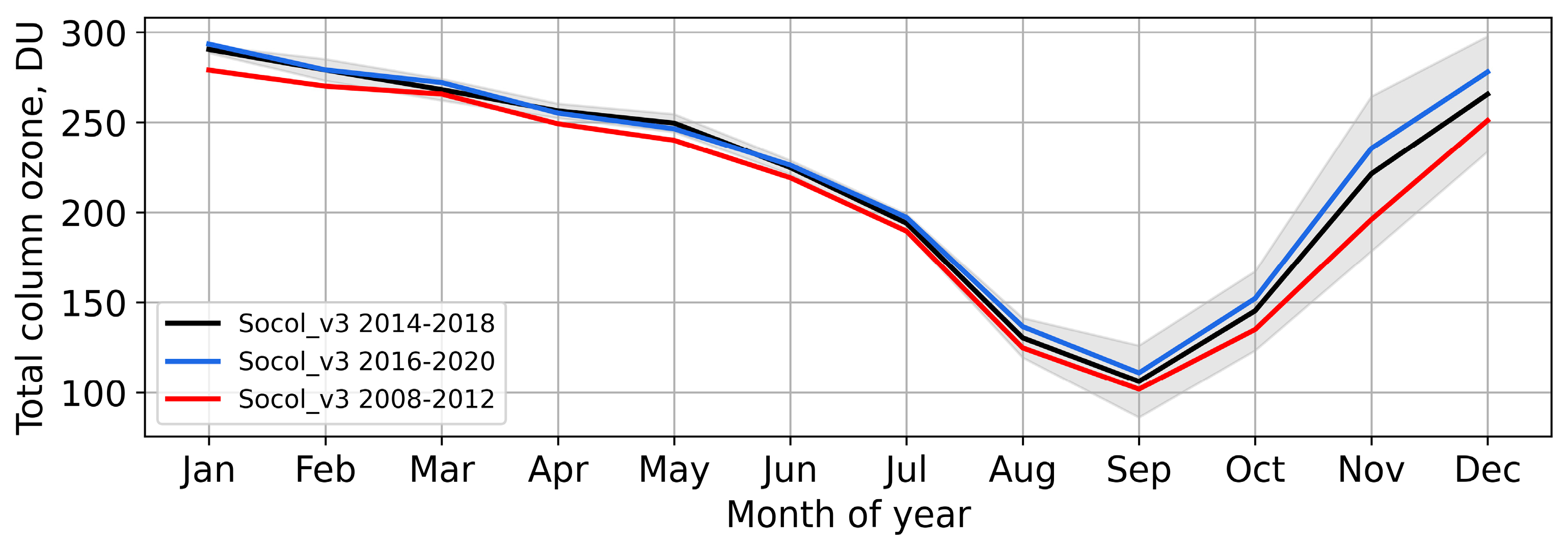
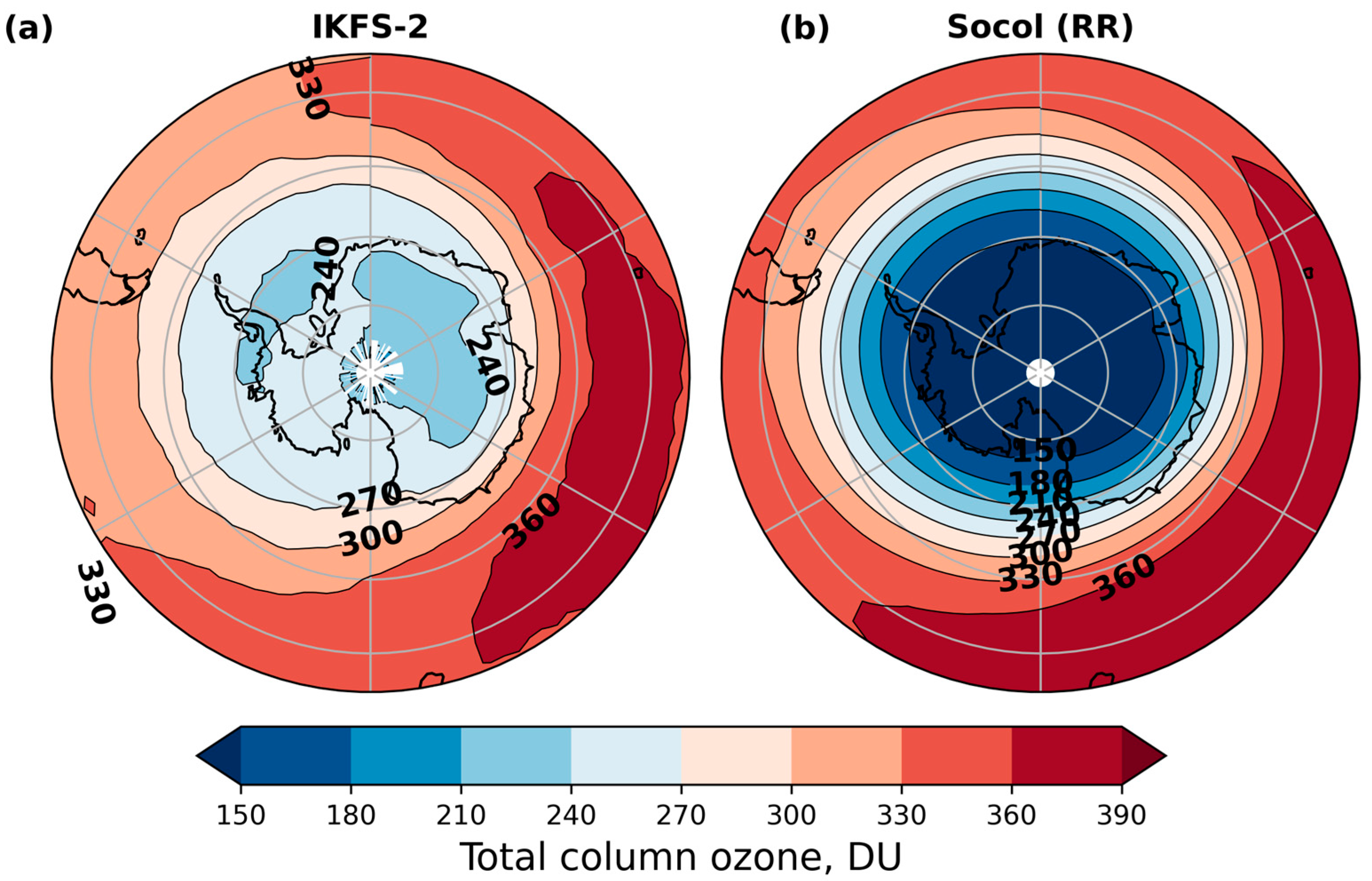

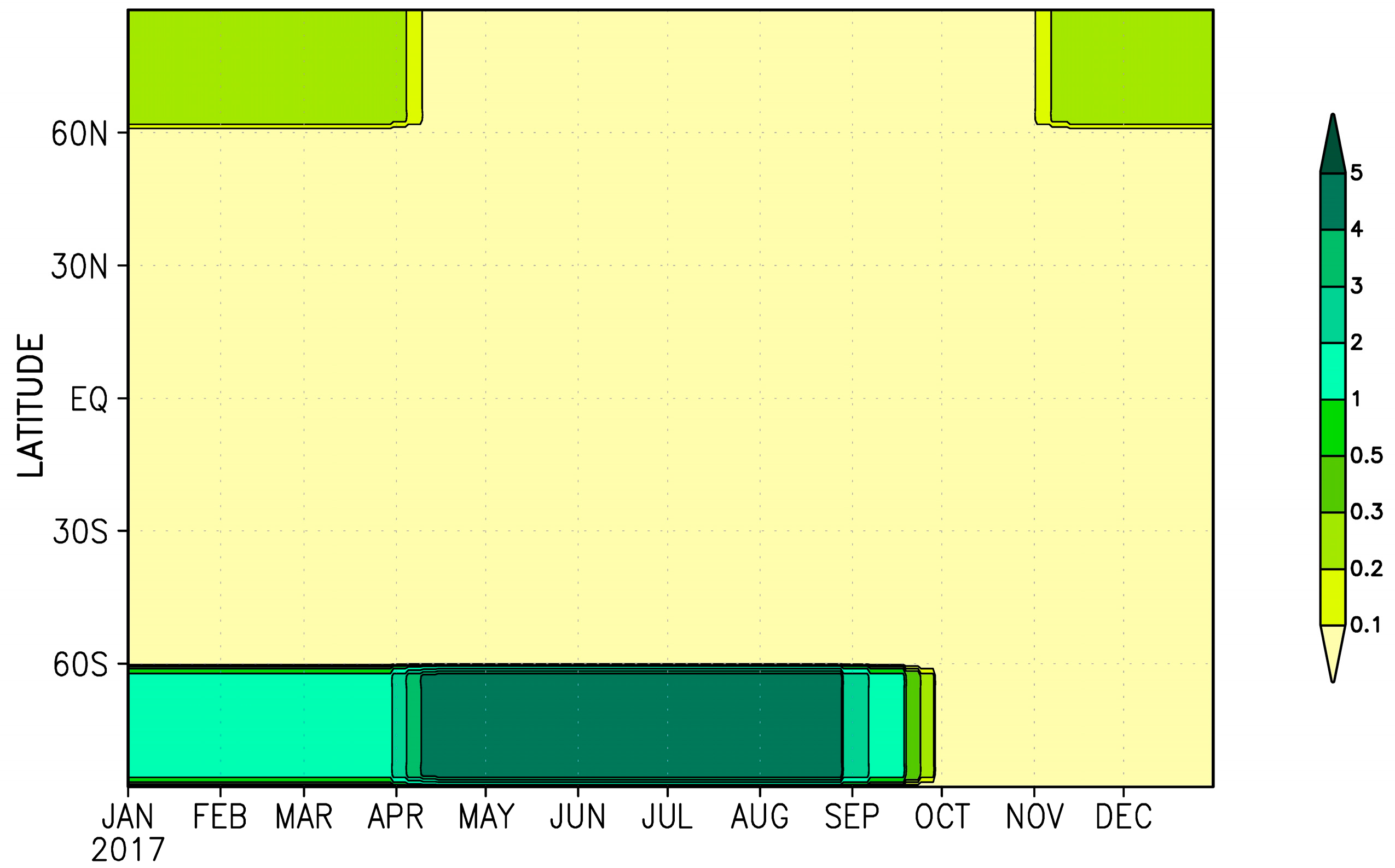

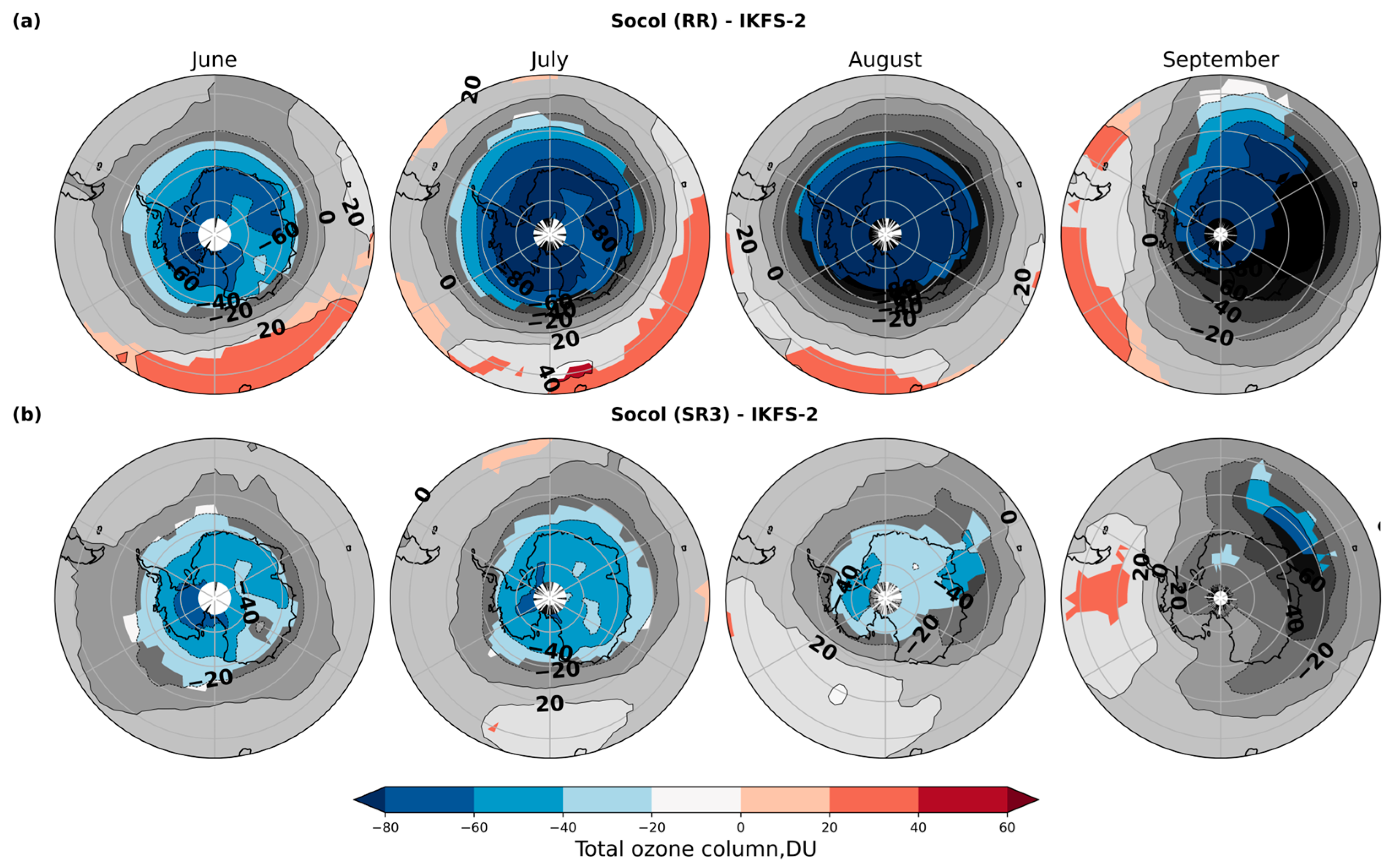
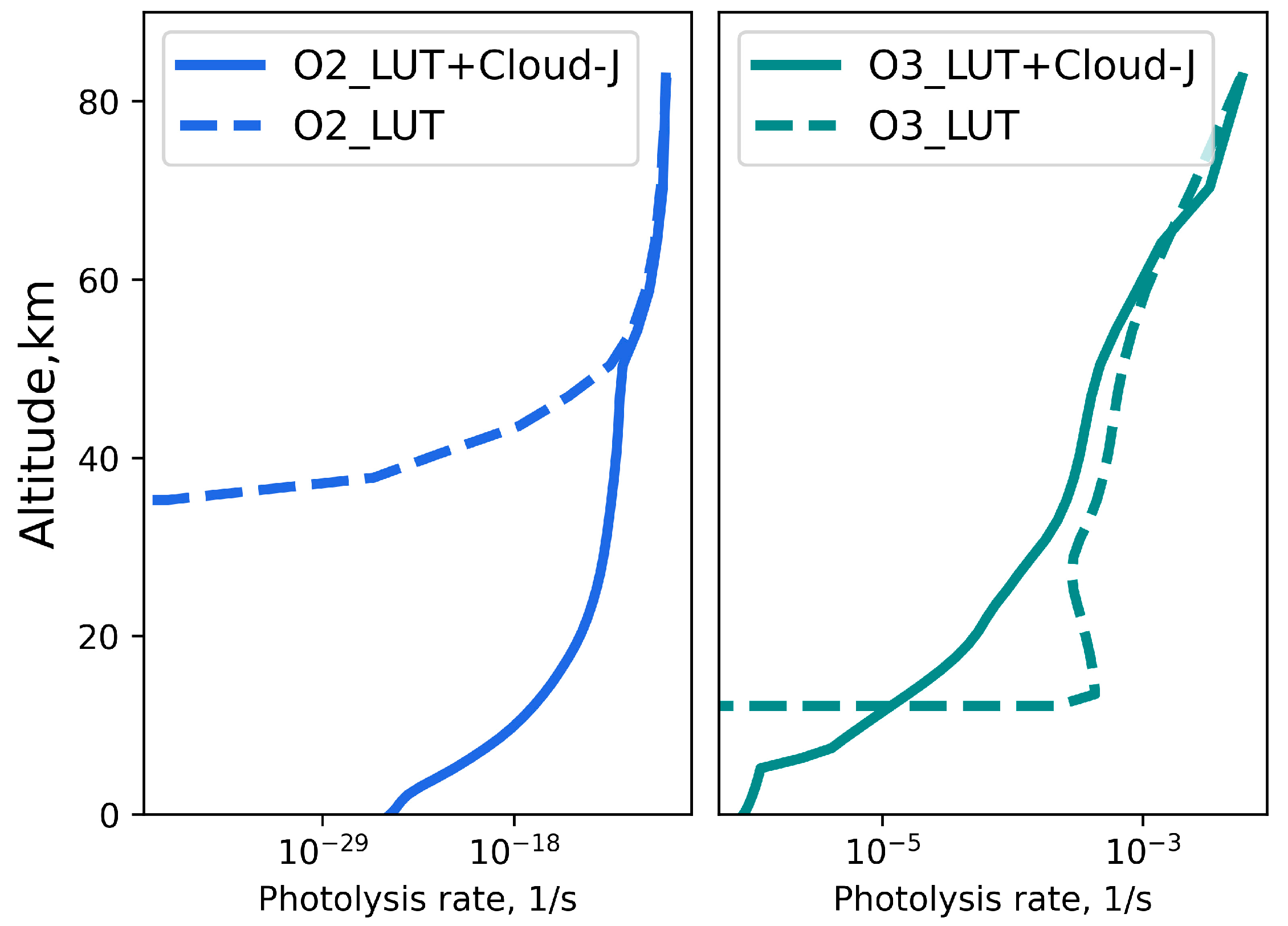
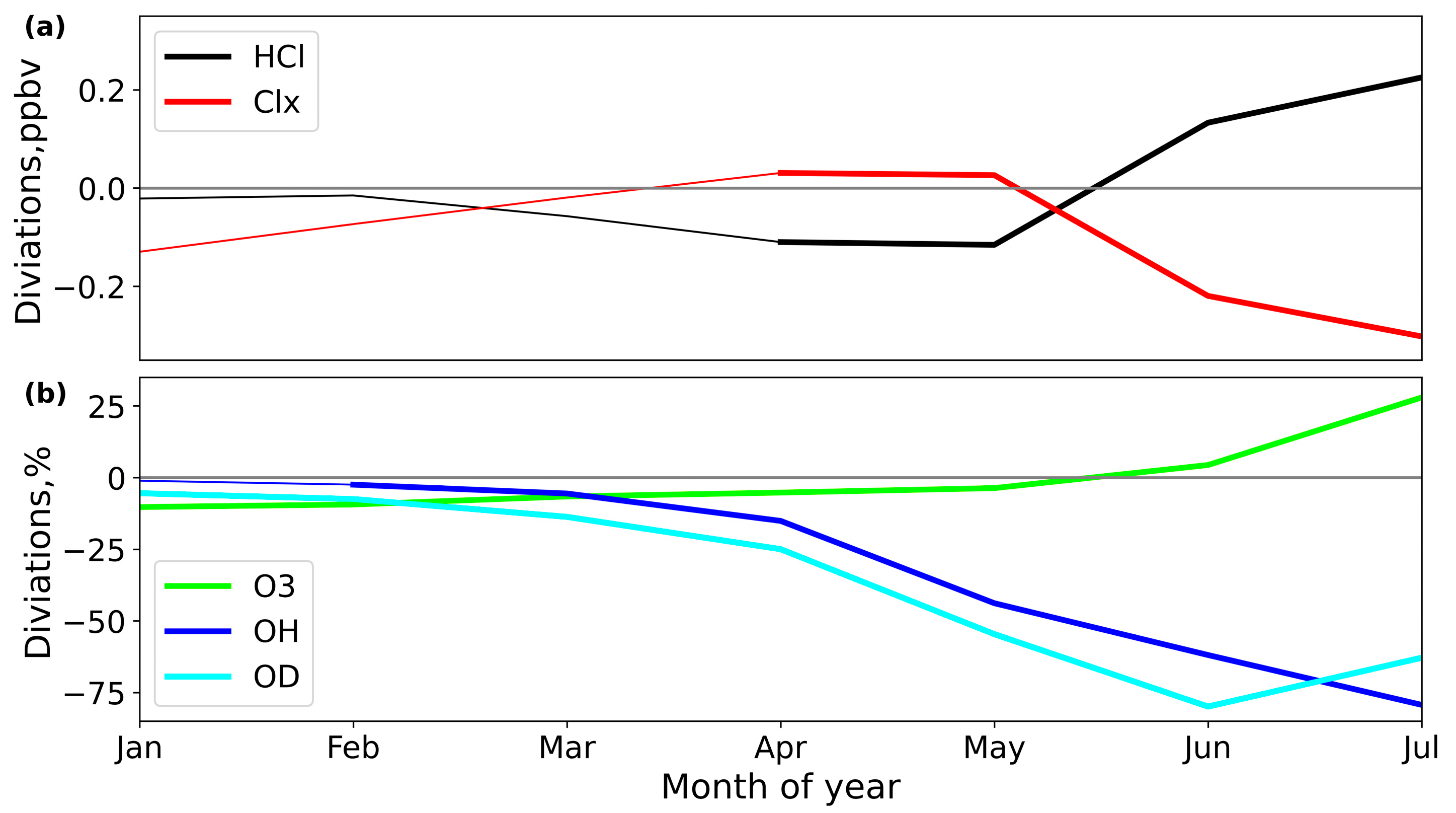
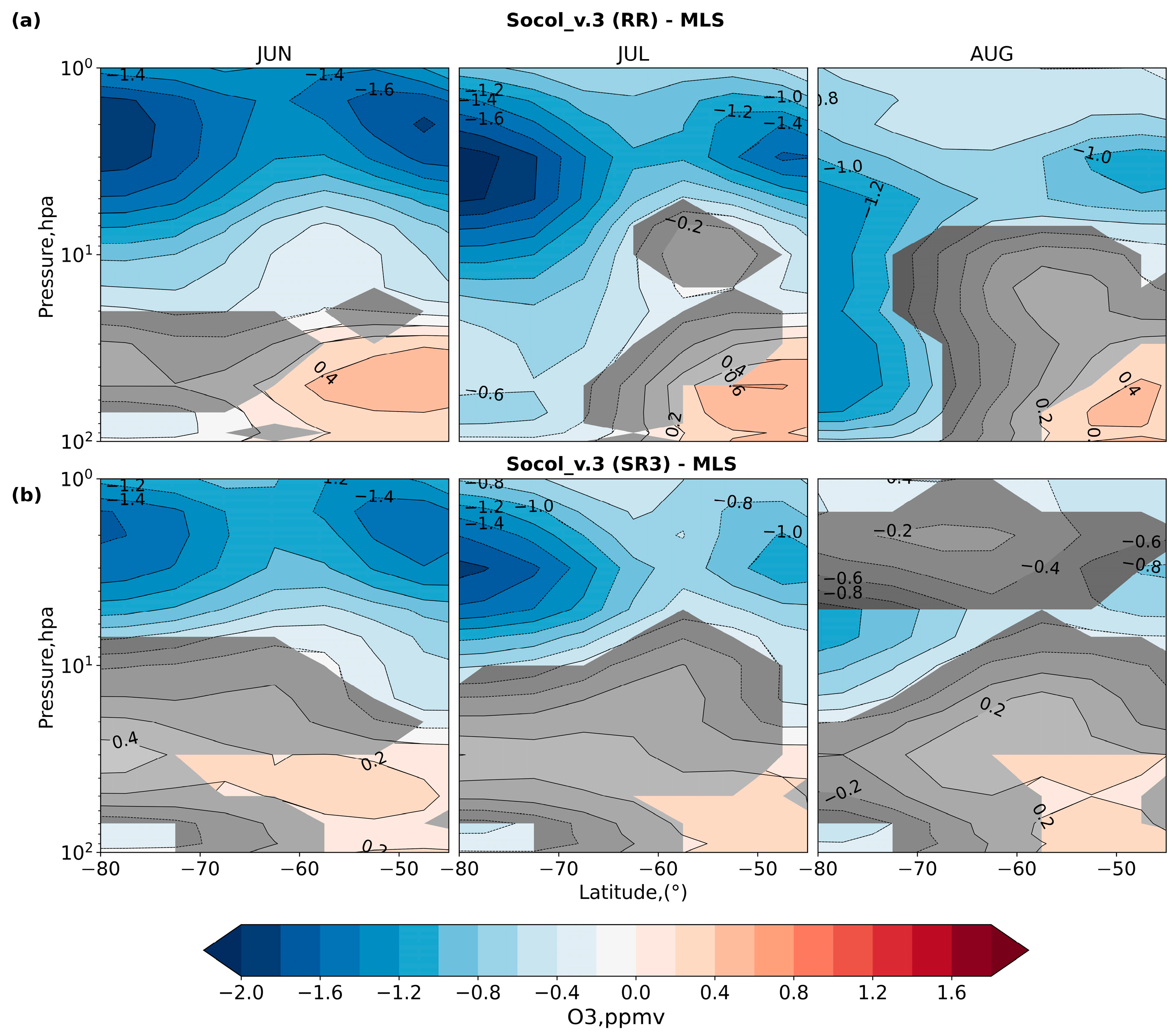

| Instruments | Satellite | Variable | Period Used |
|---|---|---|---|
| IKFS-2 | METEOR N2 | TCO | 2016–2020 |
| MLS | AURA | O3, N2O | 2014–2018 |
| MIPAS | ENVISAT | CH4 | 2008–2012 |
| Name of Model Experiment | Short Description of the Model Experiment |
|---|---|
| RR | Reference experiment described in Section 2.4.1 |
| SR1 | Two times reduction in the heterogeneous reaction HCl + ClONO2 → Cl2 + HNO3 rate. |
| SR2 | Intensification of the horizontal mixing process of all transported model species into the SH polar vortex with diffusion coefficient Kyy = 5 × 106 m2/s in its maximum. |
| SR3 | Using the Cloud-J v.8.0 module installed in the SOCOLv3 model to calculate photolysis rates |
| Statistical Indicators | Mean Bias, DU | R2 | ||
|---|---|---|---|---|
| Experiment | July | August | September | |
| RR | 88 | 108 | 74 | 0.09 |
| SR1 | 77 | 96 | 53 | 0.22 |
| SR2 | 36 | 33 | 3 | 0.64 |
| SR3 | 50 | 36 | 34 | 0.53 |
Disclaimer/Publisher’s Note: The statements, opinions and data contained in all publications are solely those of the individual author(s) and contributor(s) and not of MDPI and/or the editor(s). MDPI and/or the editor(s) disclaim responsibility for any injury to people or property resulting from any ideas, methods, instructions or products referred to in the content. |
© 2025 by the authors. Licensee MDPI, Basel, Switzerland. This article is an open access article distributed under the terms and conditions of the Creative Commons Attribution (CC BY) license (https://creativecommons.org/licenses/by/4.0/).
Share and Cite
Imanova, A.; Egorova, T.; Zubov, V.; Mironov, A.; Polyakov, A.; Nerobelov, G.; Rozanov, E. Seasonal Cycle of the Total Ozone Content over Southern High Latitudes in the CCM SOCOLv3. Atmosphere 2025, 16, 1172. https://doi.org/10.3390/atmos16101172
Imanova A, Egorova T, Zubov V, Mironov A, Polyakov A, Nerobelov G, Rozanov E. Seasonal Cycle of the Total Ozone Content over Southern High Latitudes in the CCM SOCOLv3. Atmosphere. 2025; 16(10):1172. https://doi.org/10.3390/atmos16101172
Chicago/Turabian StyleImanova, Anastasia, Tatiana Egorova, Vladimir Zubov, Andrey Mironov, Alexander Polyakov, Georgiy Nerobelov, and Eugene Rozanov. 2025. "Seasonal Cycle of the Total Ozone Content over Southern High Latitudes in the CCM SOCOLv3" Atmosphere 16, no. 10: 1172. https://doi.org/10.3390/atmos16101172
APA StyleImanova, A., Egorova, T., Zubov, V., Mironov, A., Polyakov, A., Nerobelov, G., & Rozanov, E. (2025). Seasonal Cycle of the Total Ozone Content over Southern High Latitudes in the CCM SOCOLv3. Atmosphere, 16(10), 1172. https://doi.org/10.3390/atmos16101172









